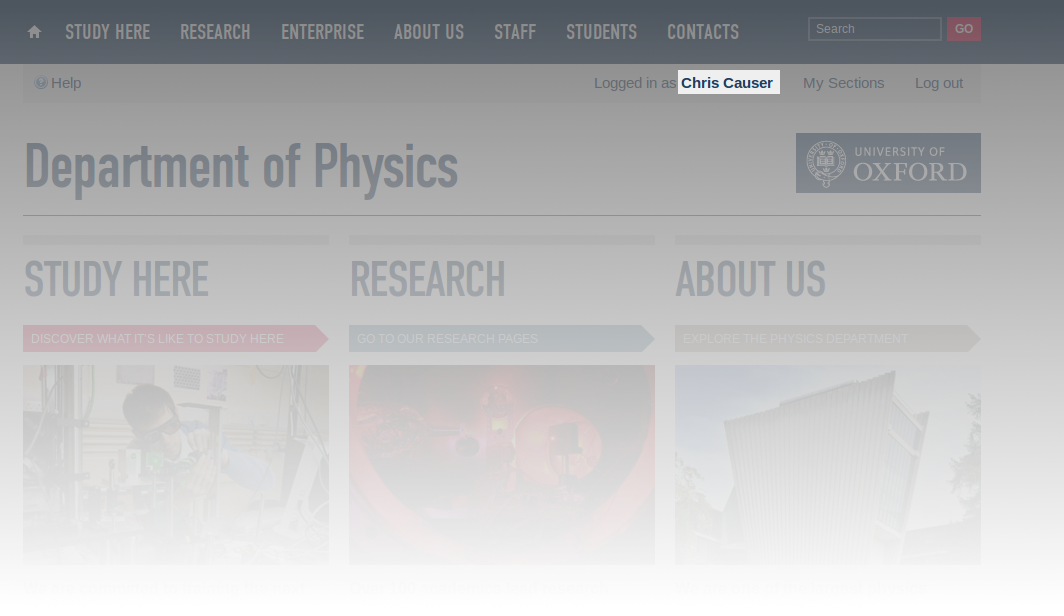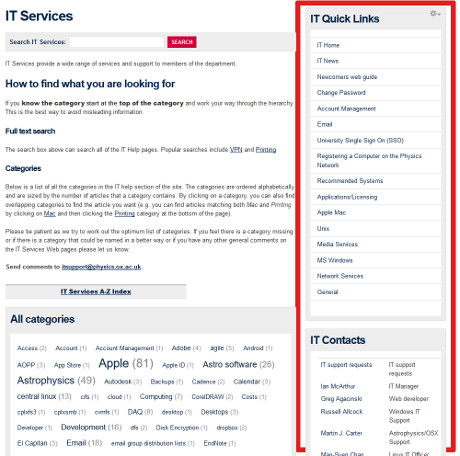Web
The CMS text editor uses a language called BBCode for its formatting. This consists of tags in square brackets, such as [b]bold text[/b] for bold text. [b] is the start tag and [/b] is the ending tag, denoted by a forward slash.
![]()
Although you can type these codes yourself, we have included a set of editor buttons which can input the code for you.
Categories: Web
What is Symplectic?
The list of publications displayed on your profile is held in a central University of Oxford database called Symplectic. For more information about Oxford's Symplectic setup, please visit the University Symplectic web page.
Categories: Symplectic | Web
Accessing your profile

The fastest way is to click the link in the top right of the website (see image above) if you are already logged in. If you are not logged in, scroll down to the very bottom of a page on the website and click 'Log in' in the bottom right-hand corner.
From your profile, you can click the edit button at the top of the screen.
Things to note
Categories: Web

Categories: Web
Generally, keyboard shortcuts follow the format "Alt+x" where x is a relevant letter- for example, "Alt+B" for bold.
To use, simply hold "Alt", then press the relevant key.
Categories: Web
Inserting images
To insert an image, click the "Insert image" button (![]() )
)
Images can be uploaded in the following formats: JPG/JPEG, PNG, GIF
Adding a caption
Generally, you will want to add a caption to an image, to explain the image contents. To do so, enter a description in the "Title text" field when inserting an image.
Categories: Web
Creating a case study
- Click on "My Sections" at the top-right of the screen
- Click "Create new case study" under "Create content"
- Enter a title for the case study
It's optional but highly recommended to add an image for the case study. To do so:
- Click "Choose file" under "Upload image"
- Select a file and click "Open"
- Click "Upload"
- Select a Case study sections for the content
Categories: Web
Creating an image gallery
When logged into the site,
- Click "My Sections" at the top-right
- Click "Create new Image Gallery" under "Create content"
- Fill in the title and body fields, as you would with a normal page
- Click the "Menu settings" dropdown and enter a title and parent item (optional)
- Click the "File attachments" dropdown
For each image:
Categories: Web
Derivative works
Any content that is based on copyrighted materials is considered a derivative work, even if heavily modified. Therefore, the copyright of the original work still applies to any derivative content- so you cannot simply crop an image and call it your own, for example.
Categories: Web
The CMS text editor uses a language called BBCode for its formatting. This consists of tags in square brackets, such as [b]bold text[/b] for bold text. [b] is the start tag and [/b] is the ending tag, denoted by a forward slash.
![]()
Although you can type these codes yourself, we have included a set of editor buttons which can input the code for you.
Categories: Web


